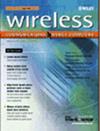Millimeter Wave Wireless Channel Knowledge Map Construction Based on Path Matching and Environment Partitioning
4区 计算机科学
Q3 Engineering
引用次数: 0
Abstract
Key technologies in 5G and future 6G, such as millimeter wave massive multiple-input multiple-output (MIMO), relies accurate channel state information (CSI). However, when the number of base station (BS) antenna increases or the number of users is large, it is rather resource-consuming to obtain the CSI. Channel knowledge map (CKM) is an emerging environment-aware wireless communication technology, which stores the physical coordinates of BS and reference locations together with the corresponding channel path information. This makes it possible to obtain CSI with light or even without pilots, which can significantly reduce the overhead of channel estimation and improve system performance, especially suitable for quasi-static wireless environments with relatively stable channels and communication systems using millimeter waves, terahertz waves, visible light, and so on. The main challenge for CKM is how to construct an accurate CKM based on finite measurement data points at limited reference locations. In this work, we proposed a novel CKM construction method based on path matching and environmental partitioning (PMEP-CC) to address the above issues. Specifically, we first sort the propagation paths between reference locations, map them to a high-dimensional space to establish the path correlation coefficient between two reference locations. Then, the communication region are divided into different subregions based on its spatial correlation. Finally, the path information at locations where no measurements are available are estimated based on the known path information within the subregion to construct CKM. Numerical results are provided to show the performance of the proposed method over related studies.基于路径匹配和环境划分的毫米波无线信道知识图谱构建
5G和未来6G的关键技术,如毫米波大规模多输入多输出(MIMO),依赖于精确的信道状态信息(CSI)。但是,当基站(BS)天线数量增加或用户数量较大时,CSI的获取非常消耗资源。信道知识地图(Channel knowledge map, CKM)是一种新兴的环境感知无线通信技术,它存储了基站和参考位置的物理坐标以及相应的信道路径信息。这使得在有光甚至没有导频的情况下获得CSI成为可能,可以显著降低信道估计的开销,提高系统性能,特别适用于信道相对稳定的准静态无线环境和使用毫米波、太赫兹波、可见光等通信系统。CKM面临的主要挑战是如何基于有限参考位置的有限测量数据点构建精确的CKM。本文提出了一种基于路径匹配和环境划分的CKM构建方法(PMEP-CC)来解决上述问题。具体而言,我们首先对参考位置之间的传播路径进行排序,并将其映射到高维空间,以建立两个参考位置之间的路径相关系数。然后,根据空间相关性将通信区域划分为不同的子区域。最后,基于子区域内的已知路径信息,估计无测量点的路径信息,构建CKM。数值结果表明了该方法的有效性。
本文章由计算机程序翻译,如有差异,请以英文原文为准。
求助全文
约1分钟内获得全文
求助全文
来源期刊
自引率
0.00%
发文量
2475
审稿时长
9.9 months
期刊介绍:
Presenting comprehensive coverage of this fast moving field, Wireless Communications and Mobile Computing provides the R&D communities working in academia and the telecommunications and networking industries with a forum for sharing research and ideas.
The convergence of wireless communications and mobile computing is bringing together two areas of immense growth and innovation. This is reflected throughout the journal by strongly focusing on new trends, developments, emerging technologies and new industrial standards.

 求助内容:
求助内容: 应助结果提醒方式:
应助结果提醒方式:


